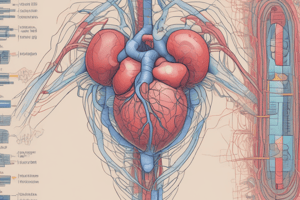Podcast
Questions and Answers
According to the text, what did Bone and colleagues propose in 1992?
According to the text, what did Bone and colleagues propose in 1992?
- That sepsis is a systemic inflammatory response to infection. (correct)
- That sepsis is a laudable event required for wound healing.
- That sepsis is a systemic infection referred to as 'blood poisoning'.
- That sepsis is a common and deadly disease.
What did Galen describe sepsis as?
What did Galen describe sepsis as?
- A systemic infection referred to as 'blood poisoning'.
- A laudable event required for wound healing. (correct)
- A common and deadly disease.
- A rotting flesh and festering wounds.
What did the germ theory propose in the nineteenth century?
What did the germ theory propose in the nineteenth century?
- That sepsis is a common and deadly disease.
- That sepsis is a systemic infection referred to as 'blood poisoning'. (correct)
- That sepsis is a systemic inflammatory response to infection.
- That sepsis is a laudable event required for wound healing.
What did research in the past 20 years reveal about sepsis?
What did research in the past 20 years reveal about sepsis?
Which of the following is a key contributing factor to organ failure in sepsis?
Which of the following is a key contributing factor to organ failure in sepsis?
What is the role of neutrophil extracellular traps in inflammatory processes during infection?
What is the role of neutrophil extracellular traps in inflammatory processes during infection?
What is the function of coagulation disorders in sepsis?
What is the function of coagulation disorders in sepsis?
What is the role of the gut in the development of sepsis-associated organ dysfunction?
What is the role of the gut in the development of sepsis-associated organ dysfunction?
Which of the following is true about sepsis-related deaths worldwide?
Which of the following is true about sepsis-related deaths worldwide?
What is the most common underlying cause of sepsis across all age groups, both sexes, and all locations?
What is the most common underlying cause of sepsis across all age groups, both sexes, and all locations?
What is the main function of Toll-like receptors (TLRs) in the host immune response?
What is the main function of Toll-like receptors (TLRs) in the host immune response?
What is the role of damage-associated molecular patterns (DAMPs) in the immune response?
What is the role of damage-associated molecular patterns (DAMPs) in the immune response?
Which of the following is NOT a criterion for septic shock according to the 'Sepsis-3' clinical criteria?
Which of the following is NOT a criterion for septic shock according to the 'Sepsis-3' clinical criteria?
Which of the following is the most common source of sepsis?
Which of the following is the most common source of sepsis?
Which of the following is the most common gram-positive isolate in sepsis cases?
Which of the following is the most common gram-positive isolate in sepsis cases?
Which of the following factors does NOT influence the incidence of sepsis?
Which of the following factors does NOT influence the incidence of sepsis?
Which organ may lack significant structural damage while still having significant tubular-cell changes that impair function?
Which organ may lack significant structural damage while still having significant tubular-cell changes that impair function?
What are the three types of anti-inflammatory mechanisms mentioned in the text?
What are the three types of anti-inflammatory mechanisms mentioned in the text?
What is the so-called neuroinflammatory reflex mentioned in the text?
What is the so-called neuroinflammatory reflex mentioned in the text?
What is a potential consequence of disrupting the neural-based system involved in the neuroinflammatory reflex?
What is a potential consequence of disrupting the neural-based system involved in the neuroinflammatory reflex?
Which organ system is most commonly affected in sepsis?
Which organ system is most commonly affected in sepsis?
What is the classification of acute respiratory distress syndrome (ARDS) based on Berlin criteria?
What is the classification of acute respiratory distress syndrome (ARDS) based on Berlin criteria?
What is the recommended screening tool for delirium in septic patients?
What is the recommended screening tool for delirium in septic patients?
What percentage of sepsis survivors experience long-term cognitive impairment and functional disability?
What percentage of sepsis survivors experience long-term cognitive impairment and functional disability?
Which of the following is NOT a manifestation of sepsis?
Which of the following is NOT a manifestation of sepsis?
What is the main cause of adrenal dysfunction in sepsis?
What is the main cause of adrenal dysfunction in sepsis?
What is NOT recommended for diagnosing relative glucocorticoid insufficiency in sepsis?
What is NOT recommended for diagnosing relative glucocorticoid insufficiency in sepsis?
Which of the following is the most common accompanying abnormality in patients with suspected infection who are at risk for sepsis?
Which of the following is the most common accompanying abnormality in patients with suspected infection who are at risk for sepsis?
What percentage of encounters in the 12-hospital cohort had leukocytosis (WBC count, >12,000/μL)?
What percentage of encounters in the 12-hospital cohort had leukocytosis (WBC count, >12,000/μL)?
What percentage of encounters in the 12-hospital cohort had leukopenia (WBC count, <4000/μL)?
What percentage of encounters in the 12-hospital cohort had leukopenia (WBC count, <4000/μL)?




